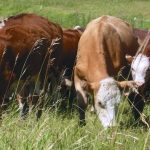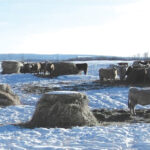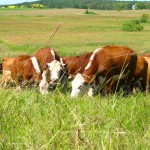Developing a grazing plan is an important first step to ensure effective grazing management on an operation, and it can help save a producer on cost of production in the long run. A grazing plan that matches animal numbers to predicted forage yields should be made before turn out. Several key steps should be included:

Making the most of available forage
Start the grazing season with a plan and lower cost of production over time

Choosing the right mineral supplements for cattle can be daunting
Whether grazing or on a winter ration, cattle need mineral supplements to avoid health problems
What mineral supplementation do I need and when do I need it? Beef producers might know they should supplement their herds with mineral, but trying to wade through all the choices at the livestock supply store can be overwhelming. Commercial suppliers seem to make claims and offer something different, but with tubs and bags of

The right time for calving depends on your farm — and you
While many producers are calving earlier, some have gone the other way
Calving season looks different on every operation — there is no one right method or time of year to calve a cow herd. While more producers in Western Canada have moved to later calving, some have gone the other way. Here are the experiences of three ranching families. Late-summer/fall calving Taralea Simpson has been calving

Intercropping can be a win win for mixed operations
The practice comes with a learning curve, but can increase grazing options while boosting soil health
There is a lot of buzz in beef and forage production systems around the concepts of sustainability and soil health, and the numerous different production practices that can support those ideas. Intercropping is one strategy that can improve efficiency and soil health. Manitoba producer Alan MacKenzie considers intercropping to be two crops that are grown

Bale grazing is having its moment in the (winter) sun
Here are some things to bear in mind when using bales to extend the grazing season
Many producers have taken steps to extend their grazing period, and bale grazing is proving to be a popular choice. Bales can be purchased or grown on farm and placed strategically in cells or ‘bale pods.’ In some cases, cattle feed on bales directly where they are dropped from the baler, but in most situations, bales

The bottom line on vaccinating cows
Not vaccinating herds comes with a cost — these two calculators put a number on potential losses
(This article has been edited for length. The full version can be found in the BCRC Blog section at beefresearch.ca.) Vaccination is a proven tool for disease prevention, but in Western Canada, one in 10 producers surveyed are not vaccinating their cows for infectious bovine rhinotracheitis (IBR) and bovine viral diarrhea virus (BVD). As well,

Comment: How much water is needed to produce a pound of beef?
And just as importantly, what kind of water are we talking about?
An excerpt from a Beef Cattle Research Council blog post on the environmental impact of beef production. For the full text, visit beefresearch.ca. Yes, it takes water to produce beef, but in the 2.5 million years since our ancestors started eating meat, we haven’t lost a drop yet. Based on the most recent science and

It’s prime time for anthrax, so keep a close eye on your cattle
Highly contagious, infectious soil-borne disease finds victims in grazing livestock
With high temperatures and drought, cattle and bison are at a higher risk of anthrax. Two bison deaths northwest of North Battleford, Saskatchewan have recently been confirmed as caused by anthrax, and seven others are suspected. Producers are encouraged to keep a watchful eye and to refresh their memories on what to do when anthrax

